How to main-line cannabis for bigger yields
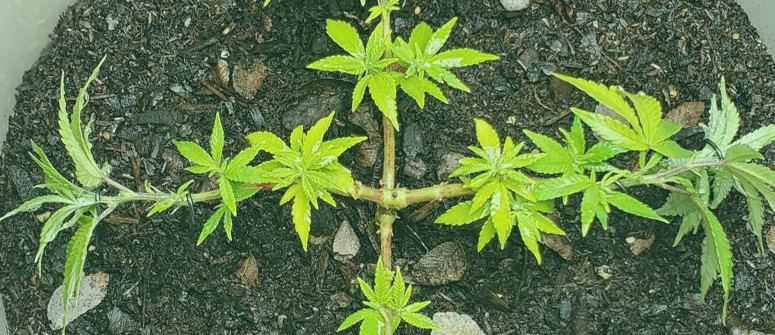
Main-lining is a high-stress training technique that involves topping cannabis plants multiple times to increase the number of main cola sites, with the potential to massively increase the final yield. Find out how to carry out this technique, and some tips for achieving the best results.
Contents:
Training techniques manipulate the way that cannabis plants grow in order to maximise yields. There are many out there; some are low-stress and not very intrusive, while others are high-stress and involve mutilating plants (to varying degrees) to change the way they grow.
In this article, we look at manifolding and main-lining cannabis, which implements elements of high-stress and low-stress training techniques to get as many as 64 main cola sites (but usually only eight), giving growers massive yields with relatively little effort.
What exactly is main-lining?
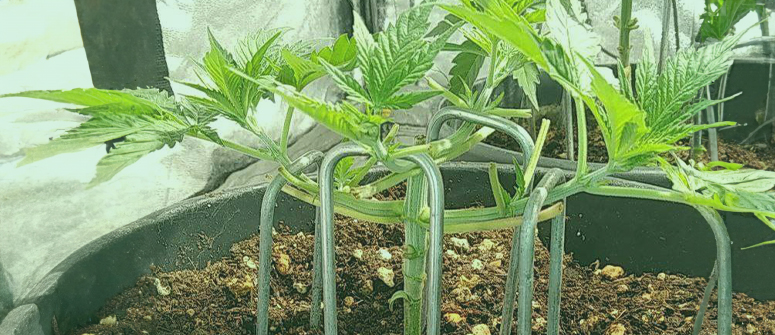
Main-lining is a high-stress training technique used to achieve bigger yields from individual cannabis plants. It works by removing the apical dominance natural to cannabis plants, and instead creates an even canopy. Unlike methods such as SOG and ScrOG, which seek to maximise yield per metre squared, main-lining increases the number of main cola sites on individual plants. So if you’re growing outdoors, or just want to grow a couple of monster plants, then main-lining is a very good option.
In brief, it involves topping plants down to their third node (once they have between five and eight nodes) and tying the remaining branches down laterally, as with LST—this creates what is known as a manifold. Then, once these branches have produced new growth, you top this new growth down to the 3rd node. Each time you top, you double the number of main cola sites.
How many colas can you generate with main-lining?
Each time a manifold is created, the number of main cola sites on that branch is doubled. So, create one, and you get two. But it can increase exponentially from here. Manifold the new growth from these two new main stems, and you will have four main cola sites. You can increase this up to 8, 16 or even 32, but we’d recommend settling for eight until you know what you’re doing.
In short, main-lining is a very simple way to massively increase the number of large colas that your plant produces, and can result in huge yields with relatively minimal effort.
Pros and cons of main-lining cannabis
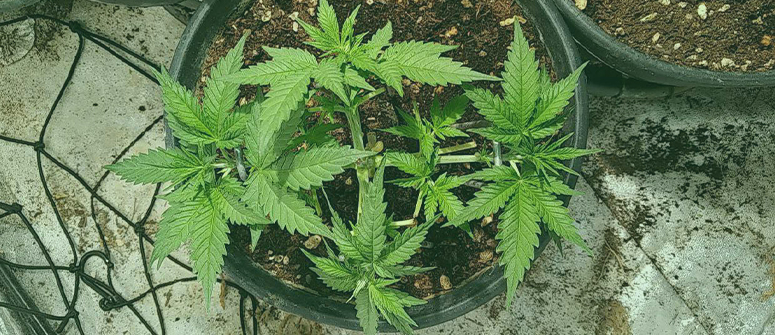
Main-lining is, as HST techniques go, fairly straightforward, so it can be effectively harnessed by practically any grower with some growing experience. Below, we outline the pros and cons of main-lining weed so that you can figure out whether it’s for you.
Pros of main-lining cannabis plants
- Creates many main colas, greatly increasing the final yield
- Fairly easy
- Gives you control over the size and shape of plants
- Works indoors and outdoors
- Can be very quick, if only done once
Cons of main-lining cannabis plants
- Cannot be used with autoflowering cannabis plants
- Requires a little extra care and work
- Takes a little more time compared to letting plants grow naturally
How to main-line cannabis plants
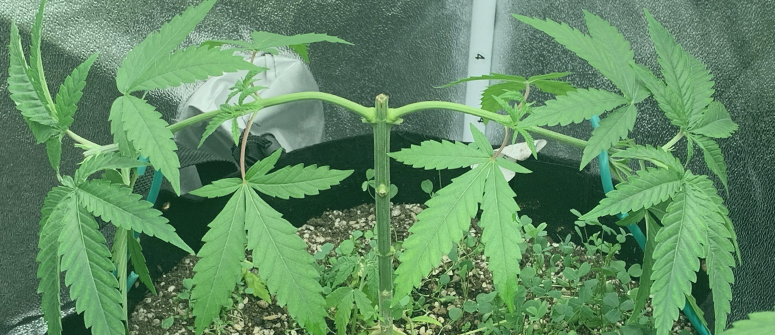
While main-lining is a fairly easy process, you have to be very careful and do it properly if you want it to be a success. There are a couple of factors to be aware of before you get started.
First, the goal is to create a symmetrical, even canopy so that all cola sites have equal exposure to light. This ensures even growth and equally sized buds, maximising yield.
Second, it is a stressful experience for your plants, so you should only cut them if they appear totally healthy, otherwise the stress might permanently damage them, or even kill them.
Third, it will require a little more work and dedication compared to letting plants grow naturally, so if you’re pressed for time and want a hands-off growing experience, then you should consider bypassing this method.
How long does it take to main-line cannabis?
It is advisable to allow your plants to vegetate for an extra two weeks each time you top and create a manifold. So if you top once, main-lining will add two weeks onto your grow time; if you top twice, four weeks; and so on.
So for most growers, main-lining adds around four weeks of extra grow time, and all of this will be during the vegetative stage—flowering will remain normal.
Extra vegging time gives the plant more time to recover from the stress of being topped and helps it to develop new growth capable of carrying heavy colas further down the line, so the extra time is worth it as it leads to bigger yields. So you mustn’t get impatient and flip your plants early, as this will be counterproductive.
And if you notice a plant responding poorly to being topped, showing signs of wilting or slowed growth, give it some extra time to veg, as this is the time during which it can heal. Let it veg long enough, and by the time it flowers it should still deliver a good yield.
Directions
- Allow your seedling to grow until it has between 5 and 8 pairs of leaves. Once it’s ready, it’s time to create your first manifold. Identify the third node (where branches sprout laterally from the main stem) from the base, and cut everything above this away with a single, clean cut to the main stem. Now, the top of your plant should have two branches growing out to the sides. Allow your plant to grow for 2 weeks, giving it time to recover.
- Cut away everything beneath the top branches (the first and second nodes), so that all you have left are the two top branches and the main stem.
- Using plant ties, gently tie down the two top branches so that they grow in a lateral fashion. You have now created your first manifold. You could continue normally from here and harvest two main colas, but most will continue to make eight main colas. If you only want two, then jump to step 8.
- Treat the plant normally and adjust the plant ties to ensure that growth remains horizontal.
- Once each of the two main stems has four nodes with decent-sized leaves, you can repeat the topping process on each side. Cut away above the third node on each side, leaving each main stem with three pairs of leaves. You have just prepared your plant to develop four top shoots; give it another two weeks to recover, tying down its top branches.
- Now it's time to create the final manifold. Cut off all growth above the third node, leaving the first and second intact. As such, you will have four pairs of leaves on each main stem, and four tops, each of which will develop two shoots, so in total, you will have eight main colas (top shoots) in the end.
- Allow your plant to veg until it has reached the desired size. During this time, treat it normally and adjust the plant ties at least twice a week to ensure even, lateral growth across the whole plant, creating an even canopy where each main cola will get an equal amount of light. Remember: symmetry is essential!
- Flip the lighting to a 12/12 cycle once your plant reached the desired height.
Tips for main-lining cannabis plants
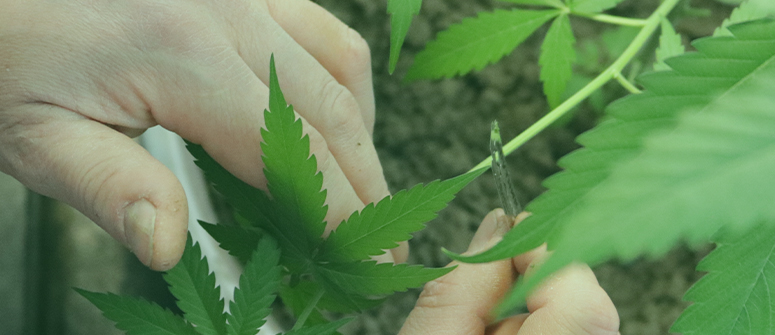
The above instructions have covered all of the main points surrounding how to manifold and main-line cannabis plants. But there are a few extra considerations that will help you to get the very most out of your training ventures, maximising yields and keeping your plants as happy as they can be (considering you’re chopping their heads off).
- Trim fan leaves: Do this either just before or just after the plant switches to flowering. Trimming away excess growth is particularly important for main-lined plants, as it helps them to send nutrients to the main cola sites, which need a lot to reach their full potential.
- Use seeds, not clones: Plants that grow from seeds will always grow symmetrically (unless there’s something wrong with them), and as symmetry is the name of the game with main-lining, this tendency puts you in good stead. With this in mind, main-lining clones is more difficult and can more easily go wrong.
- Be careful when tying branches down: You must tie them firmly enough that they actually grow horizontally, but not so tightly that you damage them. Topping is already stressful, and a snapped branch might be more than a plant can handle. Also, twine or plant ties are better than cable ties, which can be too harsh for the flesh of young plants.
- Consider main-lining with hydroponics: This technique can work just as effectively with a hydroponic setup. So if you’re growing hydro, don’t hesitate to try it!
- Use clean scissors/secateurs: Clean, sharp blades are essential when topping cannabis plants. A blunt and/or dirty blade can increase the chances of infection and slow down the overall healing time your plant needs, both of which are a nuisance for you and your plant.
Should you main-line your cannabis plants?
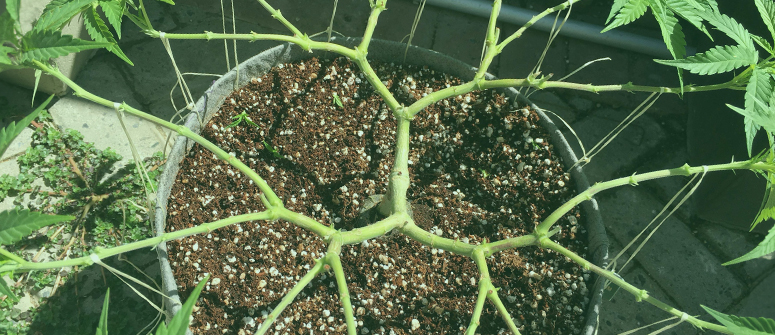
If you grow photoperiod plants and you’re into training techniques and hands-on growing methods, then you should definitely try main-lining your weed plants. It’s fairly easy and results in huge yields, so it’s certainly a winner.
While it’s quite simple and suitable for relative beginner growers, total beginners should perhaps focus their energy on getting the basics (feeding, watering, lighting, etc.) right first, and save main-lining for their next crop. As it does stress plants, mistakes made when main-lining will cause significant damage. Also, as mentioned, if you grow autoflowering plants, then main-lining isn’t a viable option.
But for those who can and want to try it, there’s very little reason not to.




